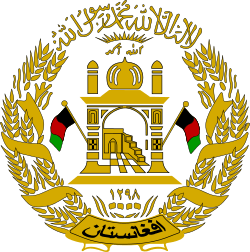Islamic Movement of Afghanistan
| Islamic Movement of Afghanistan | |
|---|---|
| Leader | Said Mohammad Ali Jawid |
| Founder | Muhammad Asif Muhsini |
| Founded | 1978 |
| Ideology |
Shia Islamism Shariati thought (Initially) |
| National affiliation | National Coalition of Afghanistan |
| Website | |
| harakatislami.af | |
|
Politics of Afghanistan Political parties Elections | |
 |
| This article is part of a series on the politics and government of Afghanistan |
|
Executive |
|
Legislature
|
|
Judiciary |
| Foreign relations |
|
Politics portal |
Islamic Movement of Afghanistan (Persian: حرکت اسلامی افغانستان, Harakat-e Islami-yi Afghanistan) is a political party and former faction of the Afghan Northern Alliance (United Front) in Afghanistan. The movement is registered as a political party with the Ministry of Justice.[1] From its foundation to 2005, the movement was led by Ayatollah Muhammad Asif Muhsini. The movement emerged in 1978, as a political formation of non- Shiites. Initially the movement was inspired by the Islamic revolutionary ideas of Ali Shari'ati, but over time this influence waned.[2][3]
In February 2005, Muhsini resigned as leader of the movement. Said Mohammad Ali Jawid, who has served in Hamid Karzai's first cabinet in 2001, became the new leader of the movement.
In April 2005, the movement joined the National Understanding Front of Afghanistan, a 12-member front of opposition parties. However, the front soon became inactive.[2]
During the 1980s, the movement was part of the 'Tehran Eight', an alliance of Shiite mujahedin factions supported by Iran that fought against the PDPA government and Soviet troops. The movement joined the Hezb-e Wahdat, which was intended as a united Shiite political front, but soon bolted out of it.[2] During the Taliban years, it joined the 'Northern Alliance'.
After the US occupation of Afghanistan, the movement was divided into two. A dissident sector broke away, and formed the People's Islamic Movement of Afghanistan. The dissidents, led by Seyyed Hossein Anwari, were based amongst the militia forces of the movement and had a more secular political outlook.
References
| ||||||||||||||||||